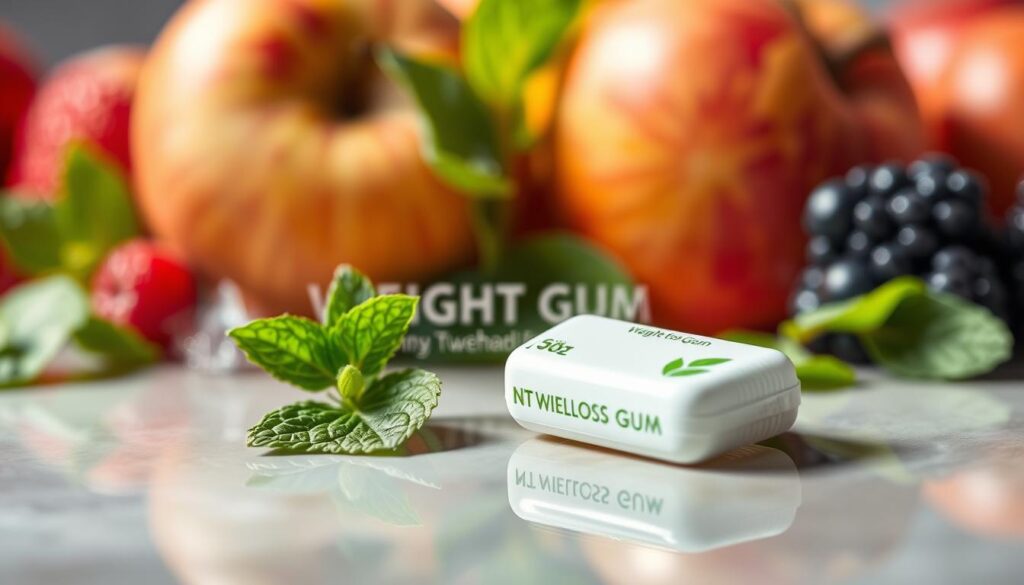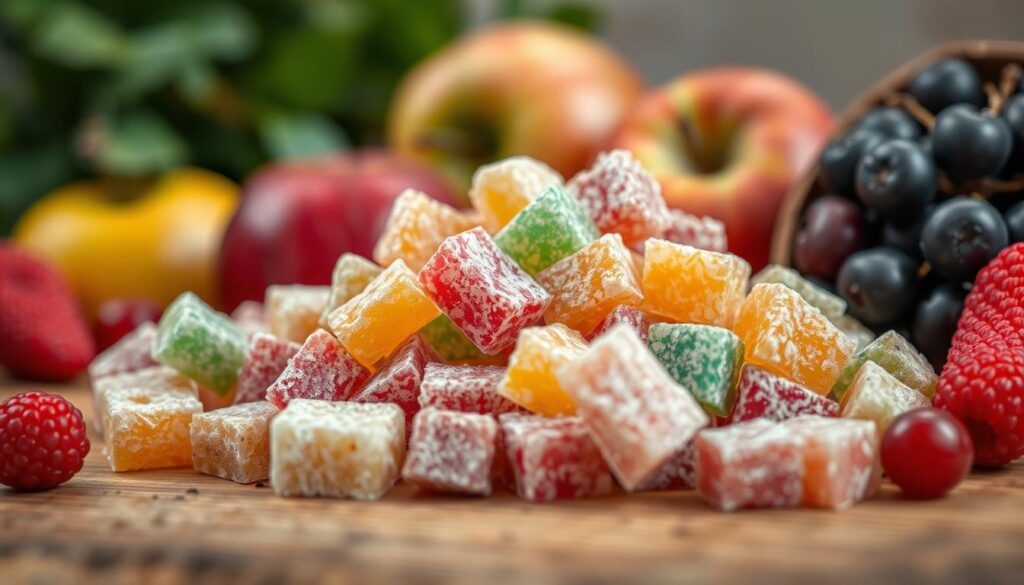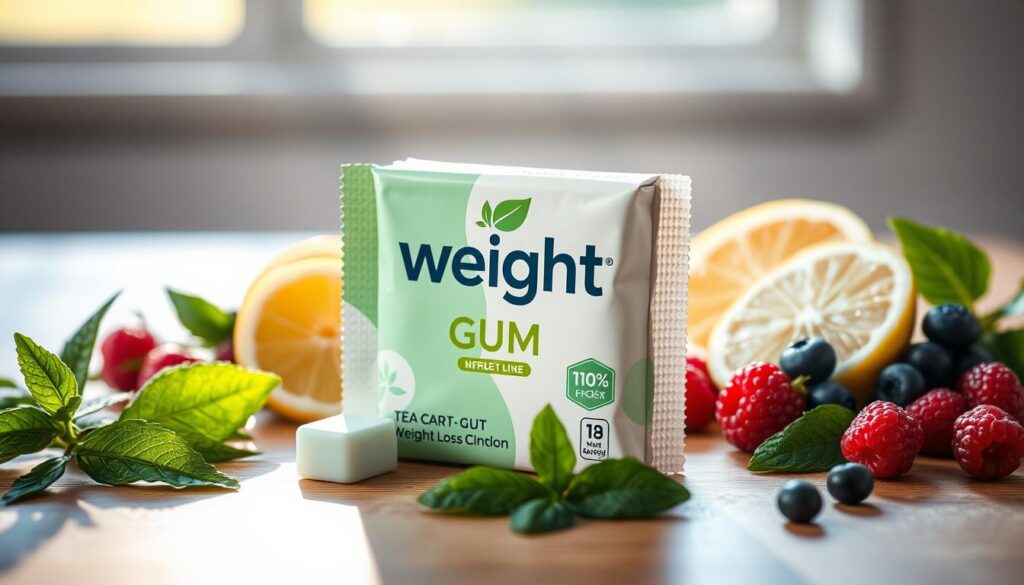Getting fit and staying healthy is tough. But weight loss gum might help. It can curb hunger and burn more calories. This could change how you manage your weight.
Chewing gum is simple but powerful. It can make you feel full and eat less. It might also speed up your metabolism. Plus, it can distract you from snacking.
Studies show weight loss gum could be very helpful. It might help you eat fewer calories and burn more. This could be the start of a healthier you. Learn how weight loss gum can change your life.
Key Takeaways
- Weight loss gum can help suppress appetite and reduce calorie intake at meals
- Chewing gum may increase calorie burn and boost metabolism
- Weight loss gum can serve as a distraction from cravings and impulse snacking
- Ongoing research suggests potential long-term benefits for weight management
- Incorporating weight loss gum into your daily routine could be a valuable addition to your health and fitness regimen
Understanding Weight Loss Gum and Its Benefits
Weight loss gum is getting more popular as a way to help manage weight. It has ingredients that can make you feel full, boost your metabolism, and even help you sleep better. These can all help you lose weight.
How Weight Loss Gum Works
Chewing gum can make you feel less hungry and less tempted by food. This is because chewing makes your mouth produce more saliva. This can make you feel full for a little while. Some gums also have caffeine or other things that can help you burn more calories.
Key Active Ingredients
- Appetite-suppressing compounds: These may include natural extracts, fibers, or other substances that can help reduce feelings of hunger and cravings.
- Metabolism-boosting ingredients: Certain vitamins, minerals, or plant-based compounds may be included to potentially increase calorie burn and support a healthy metabolism.
- Sleep-enhancing components: Some weight loss gums incorporate ingredients like melatonin or valerian root to promote better sleep quality, which is crucial for overall weight management.
Scientific Research Behind Gum’s Effectiveness
Research on weight loss gum is still growing. Some studies show it might help you eat fewer calories. But other studies say it doesn’t really help with weight loss. It’s still not clear if it works well for losing weight.
The Science of Appetite Suppression Through Chewing
Chewing affects your appetite and how much you eat. It’s not just chewing. The act of masticating starts a chain of body responses. These responses can change your hunger and cravings. Knowing this can help you use fat burning gum and metabolic booster gum for weight loss.
Chewing makes special gut hormones like peptide YY (PYY) and glucagon-like peptide-1 (GLP-1) release. These hormones help control your hunger and tell your brain when you’re full. Research shows that both heavy and light eaters eat 30% less after taking PYY. It helps stop hunger and cravings.
“The research aims to develop hPYY medication for obese individuals to take orally in pill or tablet form, or even as chewing gum, potentially offering quicker satiety due to PYY receptors in the tongue.”
Just chewing gum can also make you less hungry and delay when you want to eat again. This is because chewing keeps your mind busy and away from food thoughts.
But, not all studies agree on gum’s effect on hunger. How well it works can differ from person to person. Things like how long you chew, how often, and your metabolism matter. Try different fat burning gum or metabolic booster gum to see what helps you manage your weight.
Weight Loss Gum as a Craving Management Tool
Chewing weight management gum can help control cravings, especially between meals. It can satisfy sweet cravings without adding extra calories. Chewing gum before snacks or when cooking can stop mindless eating.
Studies show that chewing dietary fiber gum before snacks can lower sweet snack cravings and intake all day.
Timing Your Gum Usage
To use weight management gum best, time it right. Chew gum before cravings or snack times. This could be a few minutes before meals or when tempted by unhealthy snacks.
Chewing gum can distract you and satisfy your mouth, helping you resist unhealthy snacks.
Managing Sweet Tooth Cravings
Weight loss gum is great for sweet cravings. A study found chewing gum works as well as a high-calorie drink after fasting for 10 hours. Chewing gum may also release hormones that reduce hunger and food intake.
Adding dietary fiber gum to your routine can be a strong tool for weight management.
Between-Meal Support Strategy
Chewing weight management gum is helpful between meals. A study found gum chewers ate 68 fewer calories at lunch than non-chewers. But, chewing gum after meals can lead to eating more snacks later.
It’s important to chew gum wisely and in moderation for your health and wellness.
Calorie Control and Metabolic Effects
Every calorie matters when you’re trying to lose weight. Research shows that chewing weight loss gum can burn a few extra calories. It might make you burn 3-5% more calories after eating.
One study found that people who chewed weight loss gum ate 67 fewer calories at lunch. Men also felt less hungry after chewing gum. This makes it a good appetite suppressant.
Chewing gum while walking can also help. It might make your heart beat faster and you walk faster. This can burn a bit more calories and fat. But, it’s not enough to lose a lot of weight by itself. Using weight loss gum with a healthy lifestyle is best.
| Research Findings | Participants | Funding |
|---|---|---|
|
|
|
The calorie-burning and metabolic effects of weight loss gum are small but promising. Its real strength is in helping manage your weight. It can control hunger and cravings. Adding it to a healthy lifestyle can help you feel better.

Different Types of Weight Management Gum
Chewing gum might help with weight loss. There are many kinds of gum for weight management. Each one has special benefits for your health.
Sugar-Free Options
Sugar-free gum is popular for weight loss. It uses artificial sweeteners or sugar alcohols instead of sugar. This can help you not want sweet foods as much and eat fewer calories.
But, some people might feel sick to their stomach from sugar substitutes. It’s good to watch out for this.
Caffeinated Varieties
Caffeinated gum can give you a boost. It has caffeine to help you burn more calories and feel less hungry. But, don’t eat too much of it. Too much caffeine can make you feel jittery or keep you awake.
Fiber-Enhanced Formulations
Fiber-rich gum helps you feel full and aids digestion. It has ingredients like glucomannan or guar gum. These slow down how fast you digest food, making you feel full longer.
Start with small amounts of fiber gum to avoid stomach problems.
Choosing the right gum depends on what you like and need. Talking to a doctor can help find the best gum for you.
| Gum Type | Key Ingredients | Potential Benefits | Considerations |
|---|---|---|---|
| Sugar-Free | Artificial sweeteners, sugar alcohols | Curbs sweet cravings, reduces caloric intake | Potential digestive discomfort with some sugar substitutes |
| Caffeinated | Caffeine | Boosts metabolism, suppresses appetite | Consume in moderation to avoid side effects like jitteriness |
| Fiber-Enhanced | Viscous fibers (e.g., glucomannan, guar gum) | Promotes a feeling of fullness, supports healthy digestion | Introduce fiber-rich gum gradually to avoid gastrointestinal discomfort |
Incorporating Weight Loss Gum Into Your Daily Routine
Adding weight loss gum to your daily routine can help you reach your health goals. It can manage cravings, reduce hunger, and even speed up your metabolism.
Chew weight loss gum between meals to control snack cravings. Research shows it can lower calorie intake at later meals. Chewing gum makes you feel full, even if you haven’t eaten much.
Use calorie control gum during snack times or while cooking. It keeps your mouth busy, stopping you from eating unhealthy snacks. Chewing gum also burns about 11 calories an hour, helping you lose weight slowly.
Choose sugar-free weight loss gum to avoid extra calories. Gums sweetened with xylitol or sorbitol taste good without adding sugar.
Weight loss gum is best when used with a healthy diet and exercise. It works best as part of a complete healthy lifestyle. Using calorie control gum with mindful eating can help you reach your weight goals.
Mindful Eating and Chewing Strategies
Using weight management chewing gum is just one part of losing weight. It’s also key to eat mindfully. This means paying attention to your food, enjoying each bite, and chewing well.
This way of eating can make you feel full and happy. It might even help you eat less.
Proper Chewing Techniques
Good chewing is a big part of mindful eating. Eating slowly and chewing well makes you feel full. Studies show chewing food 32 times can help you eat less.
By enjoying your food, you can make your gum work better. This helps you feel full and eat less.
Creating Mindful Habits
Using weight management chewing gum mindfully can help too. Try to chew your gum slowly and think about its taste. Being in the moment helps.
Combining mindful eating with gum can help you reach your weight goals. It’s a strong way to manage your appetite.
“Chewing each mouthful of food 32 times, corresponding to the number of teeth, may experience reduced appetite and consume less overall.”
Mindful eating and chewing can change your weight journey. Slow down, enjoy your food, and use weight management chewing gum. This way, you can reach your health goals in a balanced way.
Potential Side Effects and Considerations
Weight loss gum can help with hunger and health goals. But, it’s key to know about possible side effects. Using too much or wrong can cause problems.
Sugar-free gum might have artificial sweeteners or sugar alcohols. These can upset your stomach, causing bloating, gas, and diarrhea. Watch how your body reacts and follow the right amount to use.
Gums with caffeine might make you feel jittery or keep you awake. Everyone reacts differently to caffeine. Listen to your body and adjust how much you use.
- Potential side effects of weight loss gum include digestive issues, jitters, and sleep problems.
- Artificial sweeteners and sugar alcohols in sugar-free gums may cause discomfort for some people.
- Caffeine-containing gums can lead to overstimulation, especially if consumed in excess.
Don’t rely only on weight loss gum for losing weight. It’s part of a bigger plan. This includes eating well, exercising, and healthy habits. Talk to a doctor to make sure it’s safe and works for you.
| Ingredient | Potential Side Effects | Recommended Usage |
|---|---|---|
| Artificial Sweeteners (e.g., Sorbitol, Xylitol) | Digestive issues, bloating, gas, diarrhea | Stick to recommended serving sizes and monitor individual tolerance |
| Caffeine | Jitters, restlessness, sleep disturbances | Adjust intake based on personal sensitivity and avoid excessive consumption |
| Dietary Fiber (e.g., Gum Arabic) | Potential digestive discomfort, especially for those not used to high fiber intake | Gradually increase fiber intake and stay hydrated to minimize side effects |

Weight loss gum is a tool for your health journey, not the only answer. Always check with a doctor before using any health product.
Combining Gum Use With Other Weight Loss Methods
For the best results, use weight loss gum with other good weight loss plans. This means eating well, moving often, sleeping enough, and managing stress. Gum can help, but it’s not enough on its own. It’s important to aim for lasting changes, not quick fixes.
Weight loss gum, like chewing gum diet, can help control hunger and cravings. But it’s not enough for keeping weight off for good. Use gum as part of a bigger plan that includes healthy eating, exercise, and other weight loss methods. This way, you can reach your weight loss goals better.
Weight loss is a long journey. It needs a mix of strategies to succeed. See weight loss gum as a helpful tool, not the only answer. A balanced approach will help you keep your weight off for good.


A Life-Changing Experience with This Weight Loss Supplement (Nagano Tonic)
I’ve always struggled with finding a weight loss solution that actually works for me. Like many, I’ve tried numerous diets, exercise routines, and supplements over the years—some worked for a short time, but nothing ever gave me long-term results. That was until I decided to try the weight loss supplement I found : Link to the Supplement.
From the moment I started using it, I noticed a difference. Not only did I feel more energized, but my cravings also became more manageable. The best part? I started seeing results much quicker than I anticipated! Over the course of just a few weeks, I noticed a significant reduction in belly fat and overall weight loss that I hadn’t been able to achieve before.
What makes this supplement stand out from all the others I’ve tried is how it supports me in my daily routine without any jitters or energy crashes. I’m able to stay focused and motivated, which has made it easier to stay on track with my diet and exercise plan.
This product truly exceeded my expectations, and I feel more confident and healthier than ever before. If you’re struggling with your weight loss journey like I was, I highly recommend giving this supplement a try. It’s been a game-changer for me, and I’m sure it can work wonders for you too!
Contant Them on email .. tonicnagano50@gmail.com
I’ve tried so many weight loss products over the years, but nothing worked like this supplement! Since I started using it, I’ve noticed a big difference in my energy levels and appetite control. In just a few weeks, I’ve lost weight and feel so much better. It’s been easy to stick with, and the results speak for themselves. Highly recommend this to anyone looking to make a real change!
I’ve tried so many weight loss products over the years, but nothing worked like this supplement! Since I started using it, I’ve noticed a big difference in my energy levels and appetite control. In just a few weeks, I’ve lost weight and feel so much better. It’s been easy to stick with, and the results speak for themselves. Highly recommend this to anyone looking to make a real change!
wasn’t sure what to expect, but this weight loss supplement has really impressed me! After just a few weeks of use, I’ve already dropped a few pounds and feel more motivated to stay active. It’s helped curb my cravings and boosted my energy throughout the day. I’m excited to keep going and see even better results. Definitely worth trying!
Reach them on tonicnagano50@gmail.com
I was skeptical at first, but this supplement has truly made a difference in my weight loss journey. I’ve lost weight without feeling deprived or sluggish. My cravings are under control, and I feel more confident in my body. It’s easy to incorporate into my daily routine, and the results speak for themselves. I’m so glad I gave it a try!
Thanks David, i do use the link to make my purchase. you can get too here http://surl.li/iasppy
This Nagano Tonic has been amazing! In just a few weeks, I’ve lost weight, feel more energized, and my cravings are under control. Highly recommend it!
Thats the link to purchase http://surl.li/iasppy